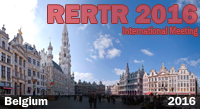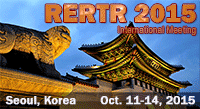 2007 International RERTR Meeting
2007 International RERTR Meeting
Abstracts and Available Papers Presented at the Meeting
ATR LEU Fuel and Burnable Absorber Neutronics Performance Optimization by Fuel Meat Thickness Variation
G. S. Chang
Idaho National Laboratory
Idaho Falls, Idaho 83415 - United States
ABSTRACT
The Advanced Test Reactor (ATR) is a high power density and high neutron flux research reactor operating in the United States. Powered with highly enriched uranium (HEU), the ATR has a maximum thermal power rating of 250 MWth. Because of the large test volumes located in high flux areas, the ATR is an ideal candidate for assessing the feasibility of converting an HEU driven reactor to a low-enriched core. The present work investigates the necessary modifications and evaluates the subsequent operating effects of this conversion.
A detailed plate-by-plate MCNP ATR 1/8th core model1 was developed and validated for a fuel cycle burnup comparison analysis. Using the current HEU U-235 enrichment of 93.0 % as a baseline, an analysis can be performed to determine the low-enriched uranium (LEU) density and U-235 enrichment required in the fuel meat to yield an equivalent K-eff between the HEU core and the LEU core versus effective full power days (EFPD). The MCNP ATR 1/8th core model will be used to optimize the U-235 loading in the LEU core, such that the differences in K-eff and heat flux profile between the HEU and LEU core can be minimized.
The depletion methodology MCWO was used to calculate K-eff versus EFPDs in this paper. The MCWO-calculated results for the LEU cases with foil (U-10Mo) types demonstrated adequate excess reactivity such that the K-eff versus EFPDs plot is similar to the reference ATR HEU case. Each HEU fuel element contains 19 fuel plates with a fuel meat thickness of 0.508 mm. In this work, the proposed LEU (U-10Mo) core conversion case with a nominal fuel meat thickness of 0.381 mm and the same U-235 enrichment (19.7 wt%) can be used to optimize the radial heat flux profile by varying the fuel meat thickness from 0.191 mm (7.5 mil) to 0.343 mm (13.5 mil) at the inner 4 fuel plates (1-4) and outer 4 fuel plates (16-19). In addition, 0.8g of a burnable absorber, Boron-10, was added in the inner and outer plates to reduce the initial excess reactivity, and the inner/outer heat flux more effectively. The optimized LEU relative radial fission heat flux profile is bounded by the reference ATR HEU case. However, to demonstrate that the LEU core fuel cycle performance can meet the Updated Final Safety Analysis Report (UFSAR) safety requirements, additional studies will be necessary to evaluate and compare safety parameters such as void reactivity and Doppler coefficients, control components worth (outer shim control cylinders, safety rods and regulating rod), and shutdown margins between the HEU and LEU cores.
![]() Full paper in PDF format
Full paper in PDF format
- ATR LEU Fuel
and Burnable Absorber Neutronics Performance
Optimization by Fuel Meat Thickness Variation, G.S.
Chang
[PDF, 162KB, 12 pages]
IMPORTANT NOTE:
Download the latest and free version of
Adobe's
Reader to view documents in PDF format. If you have questions about
or problems with downloading, installing or using Adobe's Reader, please visit the
Adobe
website.
![]()
Problems viewing/ printing PDF files
Should you experience problems with viewing/printing the PDF files:
![]() PDF Help Notes (link opens in new browser
window)
PDF Help Notes (link opens in new browser
window)
Contact:
Dr. Jordi Roglans-Ribas
Technical Director, RERTR Department
Nuclear Engineering Division – 362
Argonne National Laboratory
9700 South Cass Avenue
Argonne, IL 60439
Fax: +1 630-252-5161
![]()




